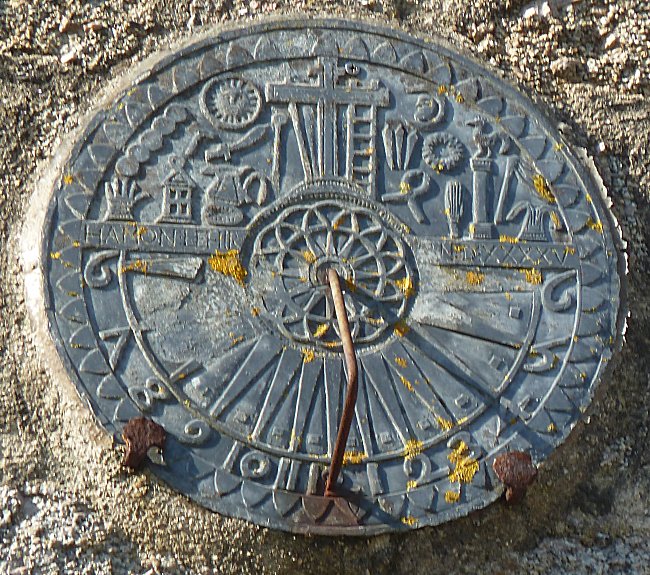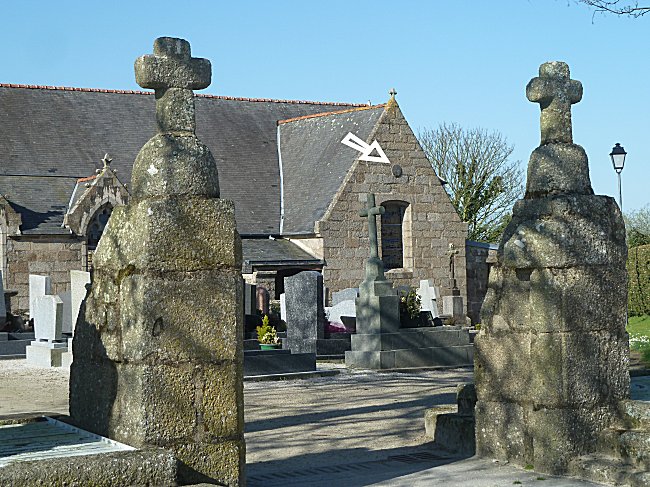Access :
This sundial is fixed on the south gable of the transept of Saint-Rivoaré church, almost above the Cimetière des Saints. It is accessed through the cemetery from the large car park.
It is a vertical south-facing dial1 from the 18th century, engraved on a circular slab.

The shadow of a metallic style inclined and parallel to the axis of rotation of the Earth moves on the lower semicircle.
The hours from 6 to 12 are shown in the left quarter, and those from 1 to 6 appear on the right. The indexes indicating hours are in relief.
Read the indicated time:
In the photo above, taken in mid-April, it is about 16 hours to true solar time. To obtain the legal time, it is necessary to add to these sixteen hours the equation of time2 (which is about zero at this time of the year), the correction of longitude (which is +14 minutes for Lanrivoaré located west of the Greenwich meridian), as well as 1 hour more because of the usual time imposed compared to Greenwich time and another 1 hour because of summer time.
According to this calculation, it was approximately 6:14 p.m. when the photo was taken on April 14, 2015. But at that moment, it was actually 6 p.m. There is a difference of + 14 minutes. No greater accuracy should be required on an old 3 dial.
The ornamentation:
The central band bears the name of the dial maker and the date of his work:


( Hamon Le Hir N ou M ? 500 : 45 .)
The same engraver having realized a dial in St-Pabu dated 1738, it is about the year 1745.
The church dates from 1583. But its transept was rebuilt in 1744. We can think that the sundial was ordered on this occasion.
The craftsman engraved various elements above the central rose window:

-
the sun and moon with a human face represent the passage of time.
Located on either side of the cross, they overlook various symbols of the Passion of Christ, superbly engraved and well adapted to the religious building to which this work of art is fixed:
-
One recognizes, in disorder, the hand of the soldier who slapped Christ, 5 denarii out of the 30 who paid Judas, the lantern of the guards having stopped Christ in the Garden of Olives, the tray stretched out to Pons Pilate with water so that he washes his hands, the chlamyde ( coat) of purple, the rope that bound Christ's hands, the hammer, the 3 nails and the pincers, the sword of St. Peter who wanted to defend Christ when he was arrested, the whip of the flogging, two spears: one pricked on the sponge soaked in vinegar and that of the soldier who made sure of Christ's death, the ladder for the Descent of the Cross, the crown of thorns, the tunic of Jesus, the column to which he was tied to receive the forty blows and the cock of Peter's Denial.
Few dials gather so many symbols so well engraved 4.
The sundial of Lanrivoaré, like many others in its time, was intended to associate images of faith with an indispensable public function. It was not until the following century and the invention of the railway that the solar hour was gradually replaced everywhere by the imposed legal hour.
Everywhere? There is still a Breton island where the solar hour always makes resistance. This island of the Iroise country is called Molène...
-1-
A dial is called 'meridional' when it is a vertical South-facing one.
-2-
The equation of time gives the correction to be made to the solar hour according to the time of the year when it is read. Indeed, the apparent movement of the Sun does not occur on the celestial equator but on the ecliptic and on the other hand, during its journey around the Sun, the Earth moves faster when the northern hemisphere is in winter rather than summer. The tables therefore indicate the correction to be made according to the period of the year.
-3-
See more detailed explanations on the correspondence between solar time and legal time on our page describing
the sundials .
-4-
For the meaning of religious emblems, read on the Internet
Yves-Pascal Castel's study .
Documentation provided by Pierre Labat-Ségalen, co-author of the book:







